Trimaran Rudders
November 15th, 2007 by: joshuaReaders will remember that we had trouble with the rudder on the TimeMachine. I’ve been collecting rudder designs in my head for an eventual redesign for the rudder on the TimeMachine. Of course, that’s not my responsibility anymore, but I thought I’d post details of all the designs I’ve examined for other people who face the same dilemma. Also notice the various outboard motor mounts.
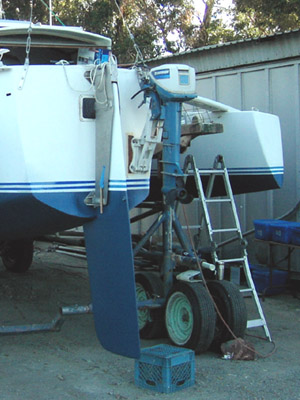
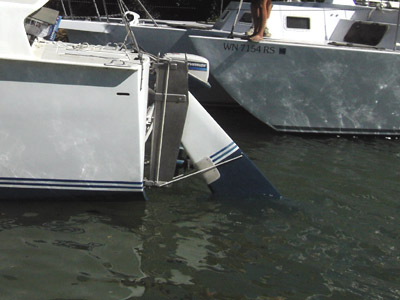
[Searunner 31, TimeMachine]
The plans for the searunner 31 included 3 rudder designs. The skeg rudder, the break away rudder, and the kickup rudder. The skeg rudder would have a fixed skeg permanently attached to the hull with the rudder surface at the trailing edge. The break away rudder design is very similar to the kickup rudder. The difference being that instead of kicking up in a box, the pintles would break free but still be repairable at sea.
As it turns out the kickup rudder box design included in the plans is simply not strong enough to handle the large surface area of the rudder. Our experience was that if the rudder kicks up while underway in a heavy sea, the forces involved simply destroy the rudder box.
If I were to build a new Searunner 31 from plans I would definitly choose the skeg rudder. It will give better control at high speeds and is shallower than the minikeel so you won’t have to worry so much about groundings. Unfortunately, retrofitting a skeg rudder would be a pretty big job.
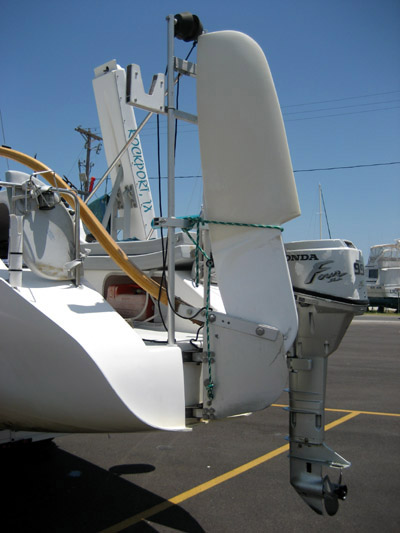
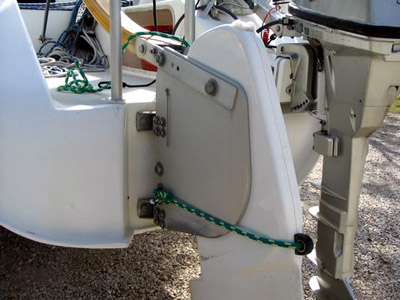
[Corsair F-31, Gimme Samoa]
The Corsair F-31 design is functionally the same as the searunner kick up design. However, there are a couple important differences. The rudder kicks up all the way completely clear of the water. The surface area is comparatively small, the pintles are much closer together, and the construction is sturdier.
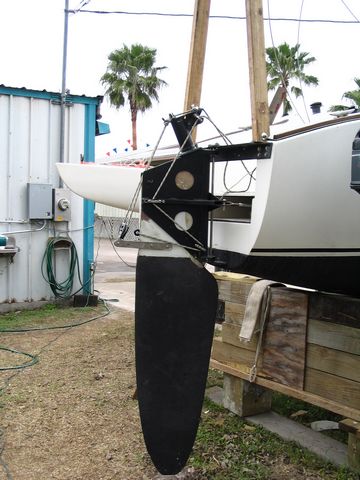
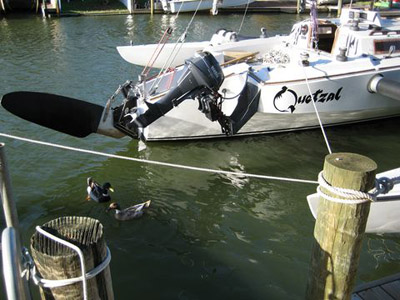
[Condor 30, Quetzal]
The Condor 30 utilizes a similar kick up design. I especially like the additional line for hoisting it clear. We could have used a system like this on the TimeMachine to prevent our rudder from being fouled. Again, the pintles are close together and the construction is very sturdy.

[Custom 30, Wing & a Prayer]
This unique design on Bill’s custom trimaran uses a dagger board in sleeve. There is no kickup ability but the depth can easily be adjusted for current conditions. Note the forward rake that provides balance as the rudder is pushed deeper.
This type of solution would be very workable on the Searunner. It has the ability to provide a very large control surface when needed, but still allow you to operate in shallow water. This is the only design I’ve seen which can be adjusted in this way. None of the kickup designs can be used half deployed. They must be fully down while underway.
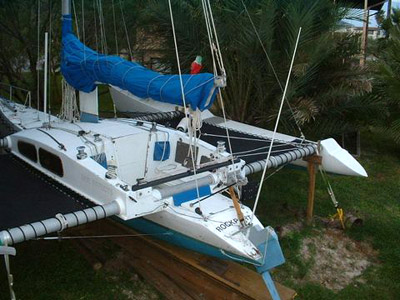
[Kurt Hughes 30, Side Effects]
The interesting thing about this Kurt Hughes design is the split lower control surface.

[Genesis 32, Tri Harder]
I don’t know much about this boat, but the rudder looks very similar to Jim Brown’s break away design.
Update: Two followup posts include photos of Jim Brown’s skeg rudder design and a custom Searunner 31 rudder based on Bill’s design above.


December 21st, 2007 at 8:41 pm
Thanks, Dad (Jeff) for some of these pictures.
January 8th, 2009 at 12:44 am
[…] rudder of my dreams. The design for this is based on Bill’s rudder on Wing and a Prayer. It is firmly mounted in a (break away) sleeve but can be raised out of danger […]
April 17th, 2010 at 5:29 pm
beautiful picture of one of my 30s that I have never seen before. Do you know who it is and do you or owner have any more.
About the rudder. That goes way back. Theory was you could have a narrow trunk, and the rudder could still kick-up even when turned without hitting the trunk.
Later I concluded that above 10 knots the rudder would probably not be turned, and below 10 knots, the damage would be minimal.
Thanks for the photo.
Kurt